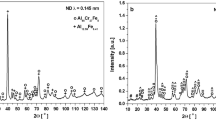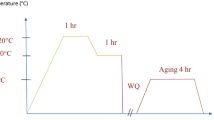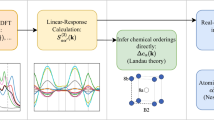Abstract
PURE uranium exists in three allotropic forms: α, which is orthorhombic and stable up to 667° C; β, which is tetragonal and stable between 667° and 775° C; and γ which is body-centred cubic and is stable between 775° C and the melting point 1,132° C. In the pure metal the phase changes occur with great speed, and investigation of the mechanisms of the changes is extremely difficult. The addition of small concentrations (∼ 0.5 atomic per cent) of certain solutes, of which chromium is one, retards the β → α change so effectively that β can be retained at moderate cooling rates to sub-critical temperatures and then allowed to proceed isothermally. White1 and others2,3, using either dilatometric or metallographic techniques, showed that the time–temperature–transformation (TTT) diagram associated with isothermal β→α transformation in various dilute uranium alloys consisted of two separate C-curves. Metallographic and crystallographic investigations4–7 have shown conclusively that the low-temperature C-curve (hereafter referred to as C3), which in U–0.5 per cent Cr alloy extends from room temperature to about 400° C, is associated with a martensitic mechanism. It was supposed that the upper C-curve, covering the range 400°–620° C in this alloy, was associated with transformation involving thermally activated atomic movement. However, metallographic observation showed that the micro-structure of the α formed at temperatures between about 525° C and 620° C was quite different from that formed between 525° C and 400° C, suggesting that two formation mechanisms were possible, one in each temperature range. In order to explore this possibility further Dixon and Burke8 redetermined the TTT diagram for a U–0.5 atomic per cent Cr alloy using an electrical resistivity method which was regarded as a more sensitive technique than those used in previous investigations. Evidence was found to suggest that the upper C-curve was composed of two overlapping C-curves, intersecting at about 520° C as required by the two-mechanism hypothesis.
This is a preview of subscription content, access via your institution
Access options
Subscribe to this journal
Receive 51 print issues and online access
$199.00 per year
only $3.90 per issue
Buy this article
- Purchase on SpringerLink
- Instant access to full article PDF
Prices may be subject to local taxes which are calculated during checkout
Similar content being viewed by others
References
White, D. W., Trans. Amer. Inst. Min. Met. Eng., 203, 1221 (1955).
Jepson, M. D., Kehoe, R. B., Nichols, R. W., and Slattery, G. F., Proc. Second Intern. Conf. Peaceful Uses of Atomic Energy, 6, 42 Geneva (United Nations, 1958).
Beaudier, Mlle. J., Cabane, G., and Mouturat, P., Mem. Sci. Rev. Met., 58, 176 (1961).
Mott, B. W., and Haines, H. R., Rev. Met., 51, 614 (1954).
Holden, A. N., Acta Met., 1, 617 (1953).
Butcher, B. R., and Rowe, A. H., Nature, 172, 817 (1953).
Butcher, B. R., and Rowe, A. H., The Mechanism of Phase Transformations in Metals, 229 (London, Inst. Met., 1956).
Dixon, P. H., and Burke, J., Inst. Met. Symp. Uranium and Graphite, Paper No. 2 (1962).
Evans, M. A. (unpublished results).
Author information
Authors and Affiliations
Rights and permissions
About this article
Cite this article
TOWNSEND, R., BURKE, J. Direct Evidence for Three Transformation Mechanisms for the β→α Phase Change in Uranium - Chromium Alloys. Nature 205, 794–795 (1965). https://doi.org/10.1038/205794a0
Issue date:
DOI: https://doi.org/10.1038/205794a0
This article is cited by
-
Precipitates Morphology in Iron-Diluted U–Fe Alloys
Metallography, Microstructure, and Analysis (2014)
-
The kinetics of the isothermal martensitic β → α transformation in U(Ga) alloys
Metallurgical Transactions A (1990)
-
Phase transformations in uranium, plutonium, and neptunium
Metallurgical Transactions (1973)



